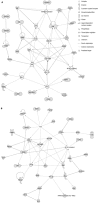miR-200 family expression is downregulated upon neoplastic progression of Barrett's esophagus
- PMID: 21448356
- PMCID: PMC3057147
- DOI: 10.3748/wjg.v17.i8.1036
miR-200 family expression is downregulated upon neoplastic progression of Barrett's esophagus
Abstract
Aim: To investigate miR-200 family expression in Barrett's epithelium, gastric and duodenal epithelia, and esophageal adenocarcinoma.
Methods: Real-time reverse transcriptase-polymerase chain reaction was used to measure miR-200, ZEB1 and ZEB2 expression. Ingenuity Pathway Analysis of miR-200 targets was used to predict biological outcomes.
Results: Barrett's epithelium expressed lower levels of miR-141 and miR-200c than did gastric and duodenal epithelia (P < 0.001). In silico analysis indicated roles for the miR-200 family in molecular pathways that distinguish Barrett's epithelium from gastric and duodenal epithelia, and which control apoptosis and proliferation. All miR-200 members were downregulated in adenocarcinoma (P < 0.02), and miR-200c expression was also downregulated in non-invasive epithelium adjacent to adenocarcinoma (P < 0.02). The expression of all miR-200 members was lower in Barrett's epithelium derived high-grade dysplastic cell lines than in a cell line derived from benign Barrett's epithelium. We observed significant inverse correlations between miR-200 family expression and ZEB1 and ZEB2 expression in Barrett's epithelium and esophageal adenocarcinoma (P < 0.05).
Conclusion: miR-200 expression might contribute to the anti-apoptotic and proliferative phenotype of Barrett's epithelium and regulate key neoplastic processes in this epithelium.
Keywords: Apoptosis; Barrett’s esophagus; Epithelial to mesenchymal transition; Epithelium; Esophageal adenocarcinoma; Proliferation; miR-200; miRNA.
Figures


Similar articles
-
MicroRNA profile in neosquamous esophageal mucosa following ablation of Barrett's esophagus.World J Gastroenterol. 2017 Aug 14;23(30):5508-5518. doi: 10.3748/wjg.v23.i30.5508. World J Gastroenterol. 2017. PMID: 28852310 Free PMC article.
-
MicroRNA expression signatures during malignant progression from Barrett's esophagus to esophageal adenocarcinoma.Cancer Prev Res (Phila). 2013 Mar;6(3):196-205. doi: 10.1158/1940-6207.CAPR-12-0276. Cancer Prev Res (Phila). 2013. PMID: 23466817 Free PMC article.
-
Progression of Barrett's metaplasia to adenocarcinoma is associated with the suppression of the transcriptional programs of epidermal differentiation.Cancer Res. 2005 Apr 15;65(8):3146-54. doi: 10.1158/0008-5472.CAN-04-2490. Cancer Res. 2005. PMID: 15833844
-
Predictors of Progression to High-Grade Dysplasia or Adenocarcinoma in Barrett's Esophagus.Gastroenterol Clin North Am. 2015 Jun;44(2):299-315. doi: 10.1016/j.gtc.2015.02.005. Epub 2015 Mar 31. Gastroenterol Clin North Am. 2015. PMID: 26021196 Free PMC article. Review.
-
Role of epigenetic alterations in the pathogenesis of Barrett's esophagus and esophageal adenocarcinoma.Int J Clin Exp Pathol. 2012;5(5):382-96. Epub 2012 May 23. Int J Clin Exp Pathol. 2012. PMID: 22808291 Free PMC article. Review.
Cited by
-
Serum miR-200c and clinical outcome of patients with advanced esophageal squamous cancer receiving platinum-based chemotherapy.Am J Transl Res. 2013 Dec 1;6(1):71-7. eCollection 2013. Am J Transl Res. 2013. PMID: 24349623 Free PMC article.
-
Protocadherin 8 (PCDH8) Inhibits Proliferation, Migration, Invasion, and Angiogenesis in Esophageal Squamous Cell Carcinoma.Med Sci Monit. 2020 Apr 24;26:e920665. doi: 10.12659/MSM.920665. Med Sci Monit. 2020. PMID: 32330123 Free PMC article.
-
Epigenetics in the Pathogenesis of Esophageal Adenocarcinoma.Clin Transl Sci. 2015 Aug;8(4):394-402. doi: 10.1111/cts.12242. Epub 2014 Nov 12. Clin Transl Sci. 2015. PMID: 25388215 Free PMC article.
-
The role of miR-200 family in the regulation of hallmarks of cancer.Front Oncol. 2022 Sep 8;12:965231. doi: 10.3389/fonc.2022.965231. eCollection 2022. Front Oncol. 2022. PMID: 36158660 Free PMC article. Review.
-
Acidic Bile Salts Induce Epithelial to Mesenchymal Transition via VEGF Signaling in Non-Neoplastic Barrett's Cells.Gastroenterology. 2019 Jan;156(1):130-144.e10. doi: 10.1053/j.gastro.2018.09.046. Epub 2018 Sep 27. Gastroenterology. 2019. PMID: 30268789 Free PMC article.
References
-
- Orlando RC. Mucosal Defense in Barrett’s Esophagus. In Barrett’s Esophagus and Esophageal Adenocarcinoma. Sharma P, editor. Oxford, UK: Blackwell Publishing, Ltd; 2006. pp. 60–72.
-
- Zwas F, Shields HM, Doos WG, Antonioli DA, Goldman H, Ransil BJ, Spechler SJ. Scanning electron microscopy of Barrett’s epithelium and its correlation with light microscopy and mucin stains. Gastroenterology. 1986;90:1932–1941. - PubMed
-
- Levine DS, Rubin CE, Reid BJ, Haggitt RC. Specialized metaplastic columnar epithelium in Barrett’s esophagus. A comparative transmission electron microscopic study. Lab Invest. 1989;60:418–432. - PubMed
-
- van Baal JW, Milano F, Rygiel AM, Bergman JJ, Rosmolen WD, van Deventer SJ, Wang KK, Peppelenbosch MP, Krishnadath KK. A comparative analysis by SAGE of gene expression profiles of Barrett's esophagus, normal squamous esophagus, and gastric cardia. Gastroenterology. 2005;129:1274–1281. - PubMed
Publication types
MeSH terms
Substances
LinkOut - more resources
Full Text Sources
Medical
Research Materials

